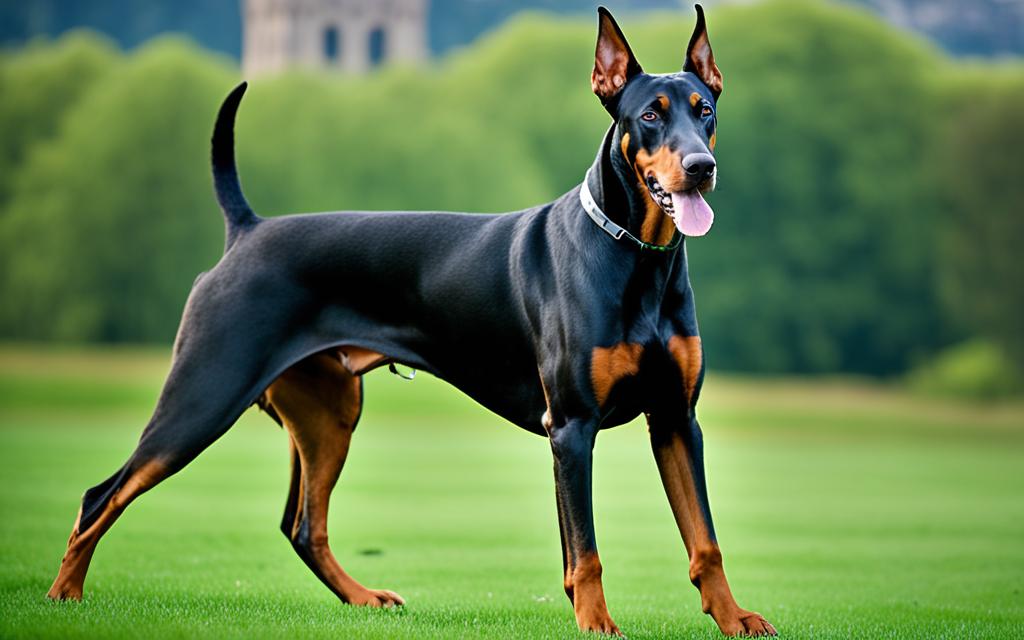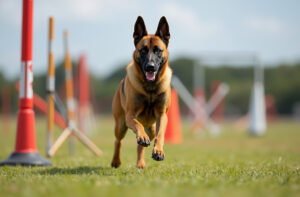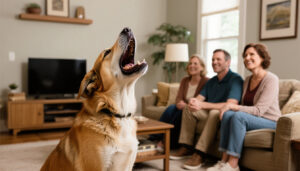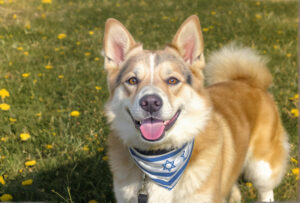
European vs American Dobermans. Did you know that European and American Doberman Pinschers, despite sharing the same breed name, have distinct physical traits, temperaments, and training abilities?
When it comes to choosing a Doberman Pinscher, it’s important to understand the differences between the European and American breeds. This article will delve into the various aspects that set them apart, from their appearances to their personalities and working aptitudes.
Key Takeaways: European vs American Dobermans
- European Dobermans have a more powerful physique and thicker coat compared to their American counterparts.
- American Dobermans are bred for elegance and have a slender appearance.
- European Dobermans are known for their feistier nature and higher working aptitude.
- American Dobermans have a calmer temperament and are often described as loving and sensitive.
- Both breeds can make excellent companions with proper training and care.
- Physical Traits: European vs American Dobermans
- Personality: Contrasting Traits in European and American Dobermans
- The Origin and Purpose of European and American Dobermans
- Training and Working Aptitude: Contrasting Abilities of European and American Dobermans
- Health Considerations: European vs American Dobermans
- Breeding Practices: European vs American Dobermans
- Cultural Perspectives: European vs American Dobermans
- The Future of European and American Dobermans: Two Distinct Breeds?
- Choosing the Right Doberman: Factors to Consider
- The Versatility of Dobermans: Great Companions in Their Own Ways
- Conclusion: European vs American Dobermans
- FAQ
Physical Traits: European vs American Dobermans
When it comes to physical traits, the European Doberman Pinscher and the American Doberman Pinscher display distinct differences that set them apart from each other. These variations contribute to their unique appearances and characteristics, making them easily distinguishable.
European Doberman Pinscher
The European Doberman Pinscher is known for its powerful and robust physique. With a thicker neck, heavier bone structure, and larger size compared to their American counterparts, European Dobermans exude strength and athleticism. Their muscular build is more pronounced, accentuating their overall presence and power.
The coat of a European Doberman is another notable feature. It is typically darker, with deep rust markings that appear vibrant against their solid black or dark brown base coat. These markings give them a striking and distinguished appearance.
American Doberman Pinscher
In contrast, the American Doberman Pinscher exhibits a more slender neck and refined bone structure. Their overall physique is leaner and more elegant, emphasizing their grace and agility. While they may have a smaller size in comparison to European Dobermans, they still possess an undeniable presence.
The coat of an American Doberman showcases lighter tan markings that beautifully contrast with their black or dark brown coat. These markings, combined with their sleek physique, contribute to their graceful and sophisticated appearance.
| Physical Traits | European Doberman Pinscher | American Doberman Pinscher |
|---|---|---|
| Physique | Powerful and robust | Slender and elegant |
| Neck | Thicker | Sleeker |
| Bone Structure | Heavier | Refined |
| Size | Bigger | Smaller |
| Coat Color | Darker with deep rust markings | Black or dark brown with lighter tan markings |
These physical differences, from overall physique to coat color and markings, contribute to the distinct appearances of the European and American Doberman Pinschers.
Personality: Contrasting Traits in European and American Dobermans
When it comes to personality, European and American Dobermans showcase distinct traits that make each breed unique. Understanding these differences can help potential owners make an informed decision about which breed is the best fit for them.
European Doberman Temperament
European Dobermans are known for their feistier nature and higher working aptitude. They possess a natural protective instinct and are often described as intelligent and family-oriented. These dogs excel in personal protection work and are highly trainable, making them reliable companions for those seeking a loyal and watchful guard dog.
Due to their protective nature, European Dobermans may exhibit a more assertive and vigilant temperament compared to their American counterparts. While they are affectionate and loving with their families, they can be more reserved and cautious around strangers. This wariness of unfamiliar individuals is a quality that suits them well in their protective roles.
American Doberman Characteristics
On the other hand, American Dobermans tend to have a calmer temperament and are often described as couch potatoes. While they are no less loyal or loving than European Dobermans, they typically exhibit a more laid-back and easygoing nature. These dogs are highly attuned to human emotions and have a sensitive side that makes them excellent companions for individuals or families seeking a loving and empathetic pet.
Despite their relaxed nature, American Dobermans still possess the intelligence and trainability shared by both breeds. However, they may require a gentler approach to training and may respond better to positive reinforcement techniques rather than firm, assertive methods commonly used with European Dobermans.
Note: It’s important to remember that individual dogs within a breed may exhibit variations in temperament. Proper socialization, training, and care can greatly influence a Doberman’s personality.
| European Doberman | American Doberman | |
|---|---|---|
| Temperament | Feisty, protective, family-oriented | Calmer, sensitive, loving |
| Working Aptitude | Higher drive, excels in personal protection work | Adaptable to various roles, including obedience and showmanship |
| Training | Responds well to firm, assertive training | Requires gentler training approaches |
As evidenced by their distinct temperaments, both European and American Dobermans offer unique qualities that can suit different lifestyles and preferences. Whether you’re looking for a feisty and protective working dog or a loving and empathetic companion, there’s a Doberman that’s perfect for you.
The Origin and Purpose of European and American Dobermans
The modern Doberman Pinscher breed has its roots in Germany, where it was developed in the late 19th century. The breed was created by a tax collector named Louis Dobermann, who aimed to develop a loyal and protective guard dog to accompany him during his work. Louis Dobermann crossed several breeds, including the Rottweiler, German Pinscher, and Weimaraner, to establish the foundation of the Doberman Pinscher breed.
The initial purpose of the Doberman Pinscher was primarily focused on personal protection and work in law enforcement. In Germany and other European countries, the breed soon gained recognition as an exceptional working dog. Dobermans were utilized for various tasks, including tracking, search and rescue, and guarding. Their high level of intelligence, loyalty, and physical capabilities made them well-suited for these demanding roles.
In contrast, the role and purpose of Dobermans evolved differently in the United States. While they were initially introduced as working dogs, their versatile traits quickly caught the attention of American breeders and enthusiasts. American breeders began emphasizing the aesthetic qualities of the Doberman Pinscher, leading to a significant focus on conformation shows and obedience trials.
“In Europe, Dobermans are primarily viewed as working dogs and are bred with a greater emphasis on their protective and working abilities,” explains Dr. Samantha Davis, a renowned European Doberman breeder. “In the United States, however, Dobermans are predominantly used as family pets, show dogs, and obedience dogs.”
The variations in breeding goals between Europe and the United States have resulted in differences in traits and temperaments between European and American Dobermans. European Dobermans tend to have a more stable temperament and a stronger drive for work, making them suitable for tasks requiring protection and heightened senses. On the other hand, American Dobermans often exhibit a calmer temperament and excel in showmanship, with a focus on complying with the American Kennel Club’s conformation standards.
It is important to note that while the primary purpose of European and American Dobermans may differ, both breeds share common traits such as loyalty, intelligence, and trainability. These qualities make them excellent companions regardless of their specific roles or origins.
The Purpose of European Dobermans
European Dobermans continue to be bred with a strong emphasis on their working abilities and protective instincts. They excel in tasks such as personal protection work, Schutzhund, tracking, and police work. European Dobermans are known for their versatility and adaptability, allowing them to thrive in various working environments.
The Purpose of American Dobermans
American Dobermans, on the other hand, have become more focused on their roles as family pets, show dogs, and obedience competitors. Their elegant appearance and calm temperament make them well-suited for these purposes. American breeders strive to produce Dobermans that excel in the conformation ring and possess a friendly and affectionate nature, making them suitable for families and individuals seeking a loyal companion.
Contrasting Purposes and Traits of European and American Dobermans
| Aspect | European Dobermans | American Dobermans |
|---|---|---|
| Primary Purpose | Working dogs, personal protection, law enforcement | Family pets, show dogs, obedience competitors |
| Temperament | Stable, protective, high drive for work | Calm, friendly, well-suited for families |
| Working Abilities | Excels in personal protection work, Schutzhund, police work | Able to participate in obedience trials and conformation shows |
| Appearance | Muscular build, thicker neck, darker coat with deep rust markings | Elegant appearance, slender build, lighter tan markings |
Training and Working Aptitude: Contrasting Abilities of European and American Dobermans
European Dobermans are renowned for their exceptional working aptitude and high drive, making them well-suited for various demanding tasks. These intelligent and trainable dogs excel in working events such as Schutzhund, IPO, and police work. Their natural instincts for protection, coupled with their heightened senses, enable them to thrive in challenging working environments.
On the other hand, American Dobermans have a different focus when it comes to training and working activities. While they can still be trained for certain working roles, their typical training objectives center around AKC conformation shows and obedience trials. American Dobermans shine in these events, showcasing their elegance, poise, and adherence to training commands.
“European Dobermans exhibit exceptional drive and are highly motivated to work, making them ideal candidates for challenging working roles. Their protective instincts and heightened senses allow them to excel in various demanding tasks.”
Although American Dobermans may not possess the same level of natural working aptitude as their European counterparts, they can still be trained to perform specific roles. These dogs can learn and excel in obedience training, which highlights their cooperative and trainable nature.
To summarize:
| European Dobermans | American Dobermans |
|---|---|
| Excel in working events such as Schutzhund, IPO, and police work | Thrives in AKC conformation shows and obedience trials |
| Exhibit exceptional drive and working aptitude | Showcases elegance and adherence to training commands |
| Highly motivated to work and perform demanding tasks | Cooperative and trainable in obedience training |
While the European Doberman may have a stronger inclination towards working roles, it’s essential to remember that each individual dog is unique. Training methods, consistent guidance, and the dog’s specific temperament can all influence their performance in training and working activities.
Training Considerations
When it comes to training Doberman Pinschers, regardless of their lineage, consistent and firm training methods are crucial for success. Both European and American Dobermans respond well to positive reinforcement techniques and clear, assertive leadership.
Health Considerations: European vs American Dobermans
When choosing a Doberman Pinscher, it is essential to consider their health as a top priority. While both European and American Dobermans are generally healthy breeds, there are some notable differences in the prevalence of genetic defects.
Many experts and enthusiasts tend to believe that European Dobermans are less prone to genetic issues compared to their American counterparts. European breeders prioritize the health and well-being of their dogs and strive to reduce the risk of hereditary health problems through careful breeding practices.
To address genetic concerns in American Dobermans, some breeders have started importing European Dobermans into the United States. By introducing European bloodlines, these breeders aim to reduce the occurrence of certain health conditions and reintroduce the working aptitude that European Dobermans are known for.
When seeking a Doberman Pinscher, it is crucial to research and choose reputable breeders who prioritize the health of their dogs. Reputable European Doberman breeders and American breeders who import European lines can provide healthier, genetically sound puppies that may have a reduced risk of certain hereditary health issues.
Remember, responsible breeding practices and regular veterinary care are paramount in maintaining the overall health and well-being of your Doberman Pinscher. Routine check-ups, a balanced diet, regular exercise, and proper grooming are also essential elements of Doberman care.
Breeding Practices: European vs American Dobermans
When it comes to breeding practices, there are notable differences between European and American Doberman breeders. European breeders prioritize working ability and temperament, making these traits a crucial part of their breeding programs. Before breeding, European Dobermans undergo rigorous temperament testing and prove their working capabilities. This emphasis on temperament and working ability ensures that future generations maintain the Doberman’s distinct characteristics.
In contrast, some American breeders focus primarily on conforming to the standards set by the American Kennel Club (AKC). While conformation is important, working temperament plays a lesser role in their breeding decisions. This difference in breeding practices has resulted in divergent viewpoints and preferences among breeders and enthusiasts, with each group valuing different aspects of the Doberman breed.
European Doberman breeders’ approach prioritizes the continuation of the breed’s working lineage, ensuring that the dogs retain the protective instincts and intelligence for which the breed is known. By requiring temperament testing and proving their working capabilities, European breeders aim to produce Dobermans that excel in various working roles, such as personal protection, law enforcement, and working sports like Schutzhund.
American Doberman breeders, on the other hand, tend to focus more on conformity to the AKC’s breed standards, which emphasize physical appearance and structure. While some American-bred Dobermans can still excel in working roles, such as obedience and agility, their overall working aptitude may be less pronounced compared to their European counterparts. However, it’s important to note that there are American breeders who prioritize both conformation and working temperament, striking a balance between the two.
| European Doberman Breeders | American Doberman Breeders |
|---|---|
| Place emphasis on working ability and temperament | Focus on conforming to AKC standards |
| Require temperament testing and working capability proof | Less emphasis on working temperament |
| Produce Dobermans with strong working aptitude | Aim for dogs that excel in conformation shows and obedience trials |
These differing approaches within the breeding community have led to a diverse range of Doberman traits and temperaments. It is essential for potential Doberman owners to understand these differences and consider their individual needs and preferences when selecting a breeder.
Cultural Perspectives: European vs American Dobermans
In Europe, Dobermans are highly regarded as working dogs, primarily utilized for protection, working sports, such as Schutzhund, and law enforcement. Their reputation as loyal and dependable companions in these roles has shaped the cultural perspective of the breed. European breeders, therefore, prioritize traits that enhance their working capabilities and stability.
“European Dobermans are bred to perform specific tasks, emphasizing their protective nature and working abilities.”
In the United States, however, Dobermans have taken on a different role and cultural significance. They are predominantly viewed as family pets and show dogs, cherished for their beauty and companionship. American breeders focus more on conforming to breed standards set by the American Kennel Club (AKC), prioritizing traits that appeal to the show ring.
“American Dobermans are bred for their elegant appearance and calm temperament, making them well-suited as family pets.”
The cultural perspectives and historical usage of Dobermans have resulted in diverse breeding goals and preferences between European and American breeders. While European breeders lean towards maintaining the working capabilities and stable temperament of the breed, American breeders prioritize the breed’s conformation and suitability as a family pet.
Despite these cultural differences, both European and American Dobermans can make wonderful companions, providing loyalty, love, and protection to their families.
Key Differences in Cultural Perspectives:
| Europe | United States |
|---|---|
| Dobermans are primarily working dogs | Dobermans are predominantly family pets |
| Emphasis on protective nature and working abilities | Preference for elegant appearance and calm temperament |
| Historical usage in protection, sports, and law enforcement | Recognized as show dogs and companions |
While these cultural perspectives have influenced breeding goals, it’s important to note that individual Dobermans can exhibit a wide range of traits, regardless of their geographic origins. Choosing the right Doberman, whether European or American, should ultimately be based on personal preferences, lifestyle, and the ability to meet the specific needs of the dog.
The Future of European and American Dobermans: Two Distinct Breeds?
Some enthusiasts argue that European and American Dobermans have diverged to such a degree that they should be officially recognized as two separate breeds. Differences in appearance, temperament, and working aptitude are seen as indicators of distinct breed types. However, the Doberman community remains divided, and the breeds continue to coexist, offering different options for potential owners.
Doberman Pinschers are a popular breed known for their intelligence, loyalty, and protective nature. Over time, the breed has developed two distinct branches, the European Doberman and the American Doberman. These branches differ in various aspects, including physical traits, temperament, training aptitude, and cultural perspectives.
Distinctive Appearance and Temperament
European Dobermans feature a powerful and robust physique, characterized by a muscular build and thicker neck. They have a shorter and thicker coat, often with dark rust markings against a black background. In contrast, American Dobermans have a more elegant appearance, with a slender neck, refined bone structure, and lighter tan markings that contrast with their black coat.
When it comes to temperament, European Dobermans are known for their feistier nature and higher working aptitude. They exhibit a more protective instinct, making them excellent personal protection dogs. On the other hand, American Dobermans have a calmer temperament and are often described as loving and sensitive companions. While both breeds are trainable, the European Doberman responds better to firm, assertive training, while the American Doberman requires gentler approaches.
The Debate for Separate Breeds
Given the distinct differences between European and American Dobermans, some enthusiasts argue that they should be officially recognized as two separate breeds. They believe that the variations in appearance, temperament, and working aptitude warrant separate recognition. However, the debate is ongoing, with the Doberman community divided on this issue.
Those in favor of separate recognition emphasize the need to preserve and promote the unique qualities of each breed. They argue that official recognition would allow breeders to focus on preserving and developing the desired traits of their respective breed, leading to more targeted breeding practices and improved breed standards.
Opponents of separate recognition argue that both European and American Dobermans share a common ancestry and core characteristics that make them inherently the same breed. They believe that the differences between the two branches should be viewed as variations within the breed rather than as distinct breeds themselves.
The Coexistence of Two Options
Despite the ongoing debate, European and American Dobermans continue to coexist, offering potential owners two distinct options to choose from. Whether one prefers the robust physique, protective nature, and working aptitude of the European Doberman or the elegance, calmer temperament, and versatile companionship of the American Doberman, both branches provide unique qualities that appeal to different preferences and needs.
| European Doberman | American Doberman |
|---|---|
| Powerful and robust physique | Elegant and slender appearance |
| Shorter and thicker coat | Longer and thinner coat |
| Feisty nature and higher working aptitude | Calmer temperament |
| Excellent personal protection dogs | Loving and sensitive companions |
While there are ongoing discussions about the future of European and American Dobermans, the ultimate decision lies with individual breeders, enthusiasts, and potential owners. It is crucial to research and choose reputable breeders who prioritize the health, temperament, and well-being of their dogs. By making an informed decision and considering personal preferences and lifestyle, one can find the perfect Doberman companion that best suits their needs.
Choosing the Right Doberman: Factors to Consider
When deciding between a European or American Doberman, it is important to consider your specific needs and preferences as an owner. Several factors should be taken into account to ensure a compatible match for you and your new four-legged companion.
Temperament
Dobermans, both European and American, have distinct temperaments. European Dobermans are known for their feistier nature and higher working aptitude. They are protective, intelligent, and family-oriented, making them ideal for individuals looking for a loyal and vigilant companion. On the other hand, American Dobermans have a generally calmer temperament and are described as being loving, sensitive, and highly attuned to human emotions. If you prefer a more relaxed and sensitive dog, an American Doberman might be the right fit for you.
Activity Level
Consider your lifestyle and activity level when choosing a Doberman. European Dobermans are typically more energetic and require plenty of physical and mental stimulation. They thrive in an active environment where they can channel their energy through exercise or working activities. American Dobermans, while still active, have a slightly lower energy level and may be more adaptable to a less active lifestyle.
Training Goals
Think about what kind of training goals you have for your Doberman. If you are interested in working sports, such as Schutzhund or IPO, or if you need a dog for personal protection work, a European Doberman may be more suitable. They have a higher drive and working aptitude, making them excel in demanding tasks. However, if you are primarily focused on obedience training or participating in conformation shows, an American Doberman can be a great choice.
Lifestyle
Your lifestyle is an essential factor in choosing the right Doberman. Both European and American Dobermans require socialization, mental stimulation, and consistent training. Consider the amount of time you can dedicate to your dog’s exercise and training needs. Additionally, think about your living situation and whether you have enough space and a secure enclosure for a Doberman, as they require room to move and play.
Reputable Breeders
Regardless of the Doberman breed you choose, it is crucial to work with reputable breeders who prioritize the health and temperament of their dogs. Look for breeders with a proven track record and positive reputation. Research their breeding practices, ask for health clearances, and ensure the puppies are well-socialized before bringing them home.
By considering these factors and working with reputable breeders, you can find the perfect Doberman Pinscher that matches your preferences and lifestyle.
| Factor | European Doberman | American Doberman |
|---|---|---|
| Temperament | Feisty and protective | Calm and sensitive |
| Activity Level | High energy | Moderate energy |
| Training Goals | Working sports, personal protection | Obedience training, conformation shows |
| Lifestyle | Active owners, space to exercise | Adaptable to various lifestyles |
Note: The table above provides a general overview of the contrasting characteristics between European and American Dobermans. Individual temperaments and traits may vary within each breed.
Image:
The Versatility of Dobermans: Great Companions in Their Own Ways
Regardless of whether you choose a European or American Doberman, both breeds can make excellent companions. Their intelligence, loyalty, and protective instincts are valuable qualities in a family pet. However, it is important to provide proper training, socialization, and care for any Doberman to ensure they become well-adjusted and well-behaved members of your family.
Training and Socialization
Training and socializing your Doberman from a young age is crucial to shaping their behavior and temperament. Focus on positive reinforcement techniques, using rewards and praise to motivate and encourage desired behaviors. Consistency, patience, and firmness are key to successfully training your Doberman.
Additionally, socialization plays a vital role in ensuring your Doberman is comfortable and well-behaved in various environments and around different people and animals. Expose them to a wide range of experiences, including meeting other dogs, encountering unfamiliar objects, and interacting with people of all ages.
Care and Exercise
Dobermans are an active breed that requires regular exercise to maintain their physical and mental well-being. Daily walks, playtime, and interactive activities such as agility or obedience training can help fulfill their energy needs. Mental stimulation, such as puzzle toys or training sessions, is equally important to prevent boredom and destructive behavior.
In terms of care, Dobermans have a short coat that is relatively low maintenance. Regular brushing will help keep their coat healthy and shiny. Other essential aspects of care include regular veterinary check-ups, vaccinations, and a balanced diet to ensure optimal health.
The Importance of a Loving Environment
Dobermans thrive in a loving and nurturing environment where they feel part of the family. Like any dog, they require attention, affection, and companionship. Spending quality time with your Doberman, playing games, going on adventures, or simply cuddling on the couch, will strengthen the bond between you and contribute to their overall happiness and well-being.
Conclusion: European vs American Dobermans
The Doberman Pinscher breed offers two distinct varieties – the European Doberman and the American Doberman. Each type possesses unique characteristics and qualities that cater to different preferences and lifestyles.
European Dobermans are renowned for their muscular build, stable temperament, and exceptional working abilities. With their powerful physique and protective nature, they excel in tasks requiring high levels of athletic performance and personal protection.
On the other hand, American Dobermans showcase elegance and a calmer temperament. They possess a keen sense of loyalty, making them great companions in various settings. Their showmanship qualities make them ideal for conformation shows and obedience trials.
Ultimately, the choice between a European or American Doberman depends on individual needs and goals. Whether one seeks a working dog or a show dog, both varieties offer the intelligence, loyalty, and protective instincts that make Dobermans renowned companions.














